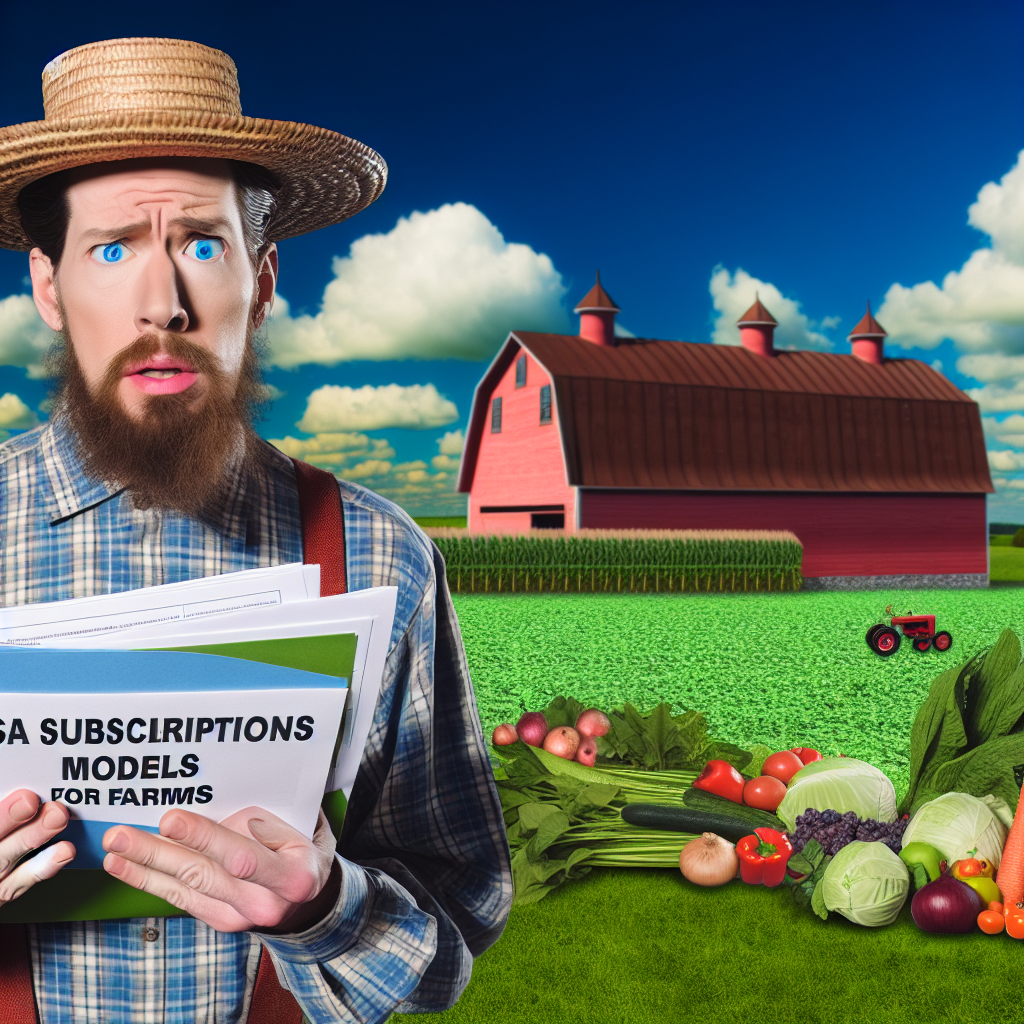Definition and Overview of Community Supported Agriculture (CSA)
Community Supported Agriculture, or CSA, is an innovative model that connects consumers directly to local farms.
CSA programs allow individuals to purchase a share of a farm’s harvest in advance.
Members share the risks and rewards of farming.
This arrangement supports local agriculture and promotes sustainable farming practices.
How CSA Works
Typically, consumers sign up for a season’s worth of produce before planting begins.
This commitment provides farmers with upfront capital to cover costs.
In return, members receive a regular supply of fresh produce throughout the growing season.
The quantity and variety of produce depend on the season and what the farm can provide.
Benefits of Community Supported Agriculture
CSAs offer several advantages for both consumers and farmers.
- Members receive fresh, seasonal produce directly from local farms.
- This model supports local economies and reduces transportation emissions.
- Farmers benefit from the security of guaranteed income.
- Additionally, CSAs foster a sense of community among members.
Types of CSA Models
Different types of CSA models cater to various community needs.
- Traditional CSAs provide a weekly share of vegetables and fruits.
- Some CSAs also include options for dairy, meat, or baked goods.
- Hybrid models allow members to choose what they want each week.
Challenges Faced by CSAs
Despite their benefits, CSAs do face challenges.
Farmers must manage the logistics of harvesting, packaging, and distributing produce.
Weather-related issues can impact crop yields, affecting member shares.
Additionally, maintaining consistent membership can be challenging.
Different Types of CSA Models
Direct-to-Consumer Model
The direct-to-consumer model connects farmers directly with consumers.
Transform Your Agribusiness
Unlock your farm's potential with expert advice tailored to your needs. Get actionable steps that drive real results.
Get StartedThis method allows consumers to purchase fresh produce without intermediaries.
Farmers often sell shares of their harvest in advance.
In return, consumers receive a weekly box of seasonal produce.
This approach fosters a strong relationship between consumers and farmers.
Moreover, it enhances community engagement and support.
Farmers benefit from predictable income during the growing season.
As a result, they can better plan their production and crop selection.
Consumers enjoy the advantage of fresher, locally sourced produce.
Group Purchase Model
The group purchase model involves multiple consumers joining together.
They collectively purchase a CSA share from a farm.
This model can make the cost more affordable for individual participants.
Groups often establish a delivery schedule to receive their produce.
Community organizations or local cooperatives usually facilitate this model.
Participants gain access to a wider array of products through shared purchases.
Additionally, this approach can reduce transportation costs.
Ultimately, group purchases encourage cooperation among community members.
Comparison of Direct-to-Consumer and Group Purchase Models
Both models offer unique benefits to consumers and farmers.
The direct-to-consumer model promotes individual relationships.
Conversely, the group purchase model emphasizes community collaboration.
Farmers must assess which model suits their business best.
They should consider their target audience and logistical frameworks.
Ultimately, consumer preferences play a significant role in these models.
Benefits of Joining a CSA for Consumers
Freshness of Produce
Joining a CSA ensures you receive the freshest produce possible.
Directly sourcing from local farms minimizes time between harvest and delivery.
Showcase Your Farming Business
Publish your professional farming services profile on our blog for a one-time fee of $200 and reach a dedicated audience of farmers and agribusiness owners.
Publish Your ProfileThis freshness translates to better flavor and nutritional value.
Additionally, you enjoy seasonal varieties, showcasing the best of local agriculture.
Variety in Selection
Participating in a CSA offers a diverse selection of produce.
You can discover new and unique items not commonly found in stores.
This variety encourages culinary exploration and creativity in the kitchen.
Every week brings surprises, ensuring meal planning remains exciting.
Support for Local Farms
By joining a CSA, you directly support local farmers.
Your subscription helps sustain small-scale agriculture in your community.
This ensures local economies thrive and remain vibrant.
In return, farmers can invest in environmentally friendly practices.
Ultimately, you contribute to a more sustainable food system.
Find Out More: Local Food Systems And Sustainable Agriculture Growth
Key Components of a CSA Subscription
Pricing
Pricing is a fundamental aspect of any CSA subscription model.
Farmers typically set prices based on their costs and expected yields.
Moreover, they often consider the market rates for similar products.
Transparency in pricing fosters trust between farmers and members.
Members should feel confident about what they’re paying for.
Additionally, offering tiered pricing can appeal to a broader audience.
Some farms may provide sliding scale options for lower-income customers.
Share Options
Share options define what members receive in each delivery.
Typically, CSA shares include a variety of fresh produce.
Farmers may offer different sizes of shares to accommodate varying needs.
For example, families might prefer larger shares, while individuals may opt for smaller ones.
Furthermore, farms can provide choices regarding select products.
Some CSAs allow members to customize their delivery contents.
This flexibility enhances the member experience significantly.
Delivery Methods
Delivery methods vary among different CSA subscriptions.
Some farms deliver directly to members’ homes for convenience.
Other CSA programs may use drop-off points in local neighborhoods.
This approach can reduce delivery costs and increase efficiency.
Understanding delivery methods is crucial for members.
They should choose a CSA that aligns with their preferences.
Reliable delivery boosts member satisfaction and encourages loyalty.
You Might Also Like: Tips for Successful Local Food Sourcing Initiatives
Challenges Faced by Farms in Implementing CSA Models
Logistical Issues
Logistics is a significant hurdle for many farms adopting CSA models.
Farmers must manage the efficient delivery of produce to their customers.
Transportation can become complicated, especially during peak seasons.
Farmers often need to invest in reliable transportation systems.
Weather conditions can also play a role in logistical planning.
Unexpected weather events can disrupt harvest schedules and delivery routes.
Showcase Your Farming Business
Publish your professional farming services profile on our blog for a one-time fee of $200 and reach a dedicated audience of farmers and agribusiness owners.
Publish Your ProfileThus, maintaining flexibility is crucial for successful operations.
Customer Engagement Strategies
Customer engagement remains a challenging aspect of CSA operations.
Building strong relationships with customers is essential for retention.
Farmers often rely on communication through newsletters or social media.
Transparent communication about seasonal changes is vital.
Furthermore, educating customers about the benefits of CSA programs enhances engagement.
Therefore, creating a sense of community helps foster loyalty.
Incorporating feedback from members can also improve service quality.
Financial Considerations
Financial management represents another challenge for farms implementing CSA models.
Farmers must balance upfront costs with expected income from subscriptions.
Seasonal fluctuations in produce availability affect cash flow.
Developing a solid financial plan can help mitigate these risks.
Additionally, diversifying offerings may improve financial stability.
Farm Management and Scalability
Effective farm management is crucial for CSA success.
Farmers often need to scale operations to meet customer demand.
However, scaling without adequate resources can pose risks.
Strategic planning helps farms expand sustainably and efficiently.
Monitoring growth and making adjustments ensures long-term viability.
Continuous training for staff on CSA operations enhances overall capacity.
Delve into the Subject: Benefits of Seasonal Eating for Sustainable Farming

Marketing Strategies for Farms to Attract CSA Subscribers
Leveraging Social Media
Social media plays a vital role in attracting CSA subscribers.
First, farms should establish a strong online presence.
They can create engaging content showcasing fresh produce.
Regularly posting updates helps create community engagement.
Furthermore, sharing customer testimonials can build trust.
Utilizing live videos can also draw interest.
Demonstrating farm activities can create a personal connection.
Platforms like Instagram and Facebook are particularly effective.
They allow for visually appealing content that attracts attention.
Community Events
Hosting local events is another strategic approach.
Farm-to-table dinners can showcase the farm’s offerings.
These events can foster relationships with local consumers.
Moreover, open farm days allow people to experience farming firsthand.
Participation in farmers’ markets increases visibility.
This interaction can lead to direct subscriptions.
Consider collaborating with local businesses for joint events.
Such partnerships can expand outreach and attract new subscribers.
Building an Email List
Email marketing remains a powerful tool for engagement.
Farms should encourage customers to sign up for newsletters.
Offering exclusive recipes or discounts can incentivize sign-ups.
Showcase Your Farming Business
Publish your professional farming services profile on our blog for a one-time fee of $200 and reach a dedicated audience of farmers and agribusiness owners.
Publish Your ProfileRegular updates keep subscribers informed about seasonal produce.
Moreover, educational content can enhance appeal.
This could include tips on food storage or preparation.
Engaging newsletters promote ongoing communication and loyalty.
Creating Referral Programs
Referral programs can significantly boost subscriptions.
Encouraging existing subscribers to share with friends works effectively.
Offering discounts for referrals incentivizes word-of-mouth marketing.
This approach leverages community trust to attract new customers.
Additionally, highlighting the benefits of CSA can be persuasive.
Sharing success stories can motivate more sign-ups.
Incentives should be clearly communicated to maximize participation.
Explore Further: Financial Benefits of Starting Agri-Tourism on Your Farm
Case Studies of Successful CSA Programs
Farm Fresh Collective
Farm Fresh Collective started its CSA program in 2015.
This program emphasizes local food sourcing.
Members receive fresh produce every week.
Farm Fresh uses social media for effective communication.
They engage customers with recipe ideas and cooking tips.
This interaction helps build a community around local farming.
Green Acres Farm
Green Acres Farm focuses on organic produce.
They offer flexible payment plans to increase accessibility.
Members can choose from various basket sizes.
Green Acres prioritizes customer feedback for continuous improvement.
They regularly survey their members about preferences.
This approach enhances member satisfaction and loyalty.
Sunshine Harvest
Sunshine Harvest integrates education into its CSA program.
They host workshops on sustainability and gardening.
Members gain valuable skills beyond receiving produce.
This educational component fosters deeper engagement.
Sunshine Harvest also collaborates with local schools.
This partnership increases awareness of healthy eating.
Lessons Learned and Best Practices
- Effective communication is vital for CSA success.
- Engagement through social media enhances community building.
- Flexible payment options increase accessibility for members.
- Regular feedback loops improve member satisfaction.
- Education programs add value and deepen relationships.
These case studies highlight various effective strategies.
Implementing these lessons can drive the success of new CSA programs.
Future Trends in CSA Models: Technology Integration and Sustainable Practices
Embracing Technology in CSA
Technology is transforming Community Supported Agriculture (CSA) models.
Farmers now utilize apps for better communication with subscribers.
This shift enhances transparency and trust between farms and consumers.
Additionally, online platforms streamline ordering and payment processes.
Farmers can showcase their seasonal offerings more effectively.
Furthermore, data analytics assists farms in inventory management.
This ensures subscribers receive fresh produce consistently.
Feeding the Local Community
CSAs enhance local food systems through direct farmer-to-consumer relationships.
Showcase Your Farming Business
Publish your professional farming services profile on our blog for a one-time fee of $200 and reach a dedicated audience of farmers and agribusiness owners.
Publish Your ProfileMoreover, these models encourage communities to support local agriculture.
This results in fresher produce, reduced transportation emissions, and economic stability.
As a result, local economies thrive when residents invest in nearby farms.
Engaging with local farmers fosters a strong sense of community.
Implementing Sustainable Practices
Sustainable practices are central to the future of CSA models.
Farmers are increasingly adopting organic farming methods to protect ecosystems.
Using cover crops, crop rotation, and reduced pesticide use enhances soil quality.
Additionally, sustainable water management techniques conserve vital resources.
These practices not only benefit the environment but also improve product quality.
Anticipating Consumer Preferences
As consumers become more health-conscious, they seek fresh, organic produce.
CSAs respond by offering customizable subscription packages to meet diverse needs.
Businesses that understand shifting consumer preferences gain competitive advantages.
This flexibility encourages more people to participate in CSA programs.
Additionally, educational programs about sustainability will increase awareness.
Building Resilience Through Collaboration
Collaboration among local farms will enhance CSA resilience.
Joint marketing initiatives can effectively expand customer bases.
Collaborations enable farms to share resources and knowledge effectively.
This community approach encourages innovative solutions to common challenges.
Ultimately, stronger networks lead to increased sustainability for all participants.
Additional Resources
Flower Farming Business: Bouquet Subscriptions — Sierra Flower …




